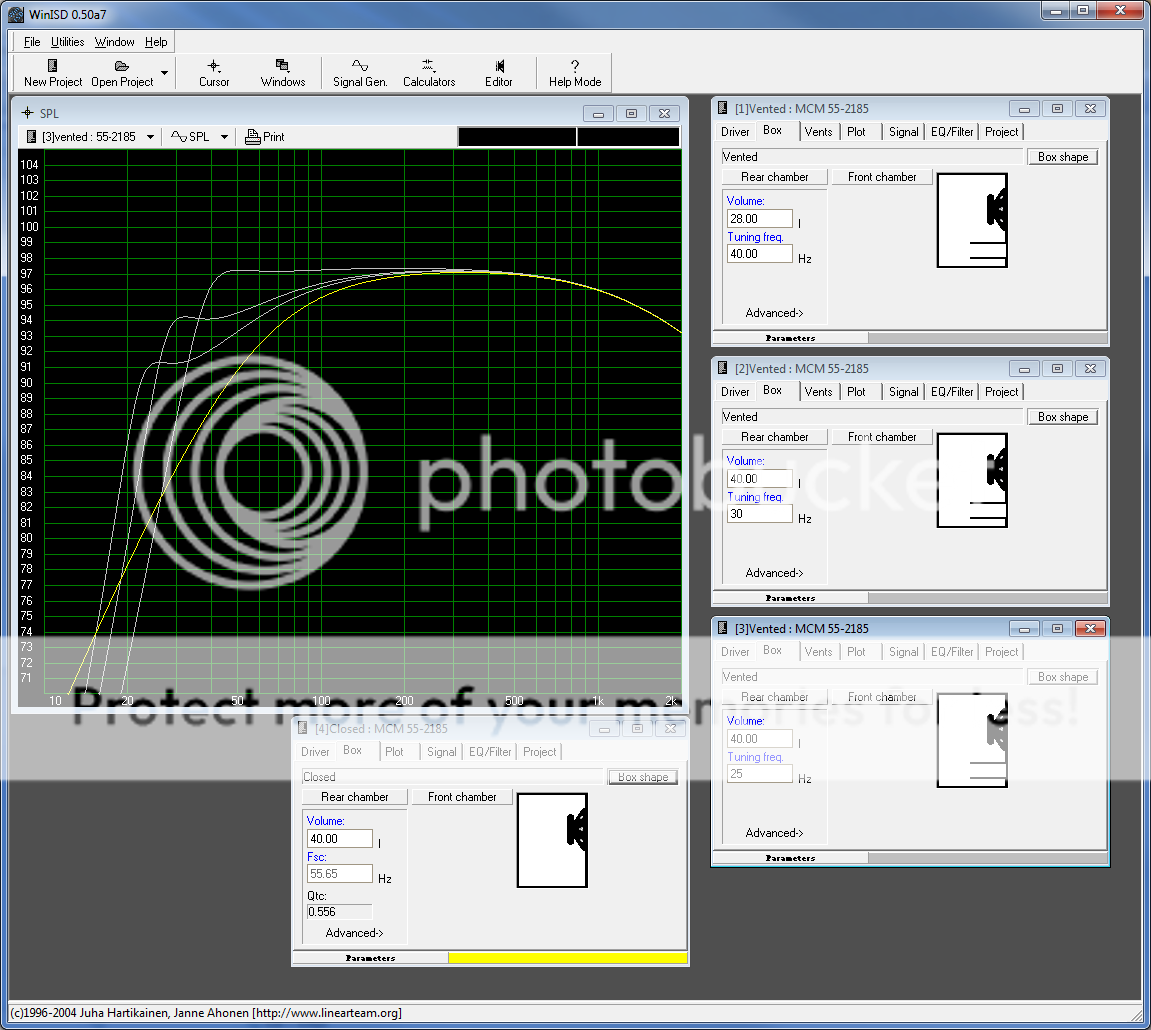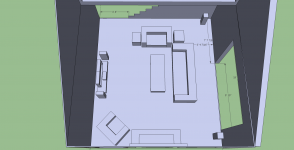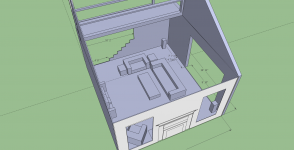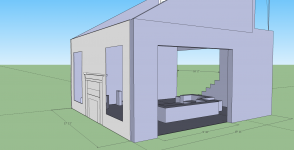(with apologies to Judy Garland...)
First things first - I've been reading these forums (and AVS, and Bill Fitzmaurice's site, and PE's Tech Talk, and... well, you get the idea) for a while and it has been a heck of an education. I only understand about 25% of what I'm reading, but the concepts are becoming clearer
I've been bitten by the DIY bug, and while I plan to eventually DIY all of my HT speakers, I thought I would begin with a (relatively!) simple subwoofer.
My HT is in my living room, which is not the most wonderful sonic environment (pic attached). It is a big space, 18x20, with a sloped ceiling and large openings to other rooms. My audio gear is decent but far from state of the art - Boston Acoustics speakers (VR30s/VR10/HD5) driven by an old Onkyo TX-SV545 receiver. I will be upgrading to a true 5.1 or 7.1 receiver in the near future - just waiting for the govt to return my money to me
So, I want to add a sub... I have a space in the room, behind the primary listening area and in the only real corner (defined as two hard walls and a standard 8' ceiling). My initial thoughts were to build one of Bill Fitzmaurice THT's, disguise it as a credenza and point it into the corner. I suspect this would work quite well, but even in my room the THT would be a large piece, primarily in depth. I would like to keep the cost of the components and structure in the $500 area, not counting finish materials.
Given that, let's assume I can build a box roughly 16" x 36" x 40" - on my back of the envelope calculations that would give me a volume of about 11 cubic feet, or 269 liters. If I use 250 liters as a working number (I have no idea how much space a port/bracing/etc would eat up) could I build a better solution than the THT?
I am not a designer, so I'm really looking more for a relatively simple plan that I can execute and finish; in other words, I *really* don't want to put it all together and then decide it is crap and pull it all apart to try again.
This setup is used for TV/movies 90% of the time, what music use it does get is more background music than a "sit and listen intently for variances in the string section" type of use.
I am much, much obliged for any help and guidance!
First things first - I've been reading these forums (and AVS, and Bill Fitzmaurice's site, and PE's Tech Talk, and... well, you get the idea) for a while and it has been a heck of an education. I only understand about 25% of what I'm reading, but the concepts are becoming clearer
I've been bitten by the DIY bug, and while I plan to eventually DIY all of my HT speakers, I thought I would begin with a (relatively!) simple subwoofer.
My HT is in my living room, which is not the most wonderful sonic environment (pic attached). It is a big space, 18x20, with a sloped ceiling and large openings to other rooms. My audio gear is decent but far from state of the art - Boston Acoustics speakers (VR30s/VR10/HD5) driven by an old Onkyo TX-SV545 receiver. I will be upgrading to a true 5.1 or 7.1 receiver in the near future - just waiting for the govt to return my money to me
So, I want to add a sub... I have a space in the room, behind the primary listening area and in the only real corner (defined as two hard walls and a standard 8' ceiling). My initial thoughts were to build one of Bill Fitzmaurice THT's, disguise it as a credenza and point it into the corner. I suspect this would work quite well, but even in my room the THT would be a large piece, primarily in depth. I would like to keep the cost of the components and structure in the $500 area, not counting finish materials.
Given that, let's assume I can build a box roughly 16" x 36" x 40" - on my back of the envelope calculations that would give me a volume of about 11 cubic feet, or 269 liters. If I use 250 liters as a working number (I have no idea how much space a port/bracing/etc would eat up) could I build a better solution than the THT?
I am not a designer, so I'm really looking more for a relatively simple plan that I can execute and finish; in other words, I *really* don't want to put it all together and then decide it is crap and pull it all apart to try again.
This setup is used for TV/movies 90% of the time, what music use it does get is more background music than a "sit and listen intently for variances in the string section" type of use.
I am much, much obliged for any help and guidance!
Attachments
Step 1 would be to find out if that location for the sub will work. Go beg/borrow/steal a small sub place it in your listening location (place it on a chari, couch, poker table...whatever...get it as close to where your head will be. Power it up and then walk over to where you intend to place the sub, and listen. Does is sound good? Or is it anemic? Move the sub to other listening positions. Does it still sound good in the corner where you intend to place the THT? If it does you are in look. You can reasonable be assured that if you put the THT in that corner that it will sound good at your listening positions. If it doesn't sound good...well you need to start looking at other placement options...or multiple subs scattered around your room.
Also ask yourself...just how loud do you want to go? THT is supposed to seriously rock...but it is not a small enclosure. A rough budget will also help calibrate this project.
Also ask yourself...just how loud do you want to go? THT is supposed to seriously rock...but it is not a small enclosure. A rough budget will also help calibrate this project.
Unfortunately, the stairs to the basement are directly under the stairs to the second floor. Plus I'd prefer to avoid any permanent "modifications" to the walls.
Is there a program and/or tutorial on designing ported boxes? This stuff is definitely interesting but wow lots to learn!
Is there a program and/or tutorial on designing ported boxes? This stuff is definitely interesting but wow lots to learn!
Oy! I downloaded WinISD (beta) from the linearteam website. The version I have is 0.44, looks like it was last updated in 2002. I'm assuming this is the latest and greatest? I've googled around for some tutorials but none of the ones I've found match the program I'm using <shrug>
I finally gave up and modeled a box 18x36x40, one port in the largest size the program offered, with a Dayton 15 driver that was in the database. I chose 17 hz as the tuning point - this was a complete and utter SWAG since I have no idea what a "tuning point" is and how it will affect the sub. If I use anything other than 1 w for power, the SPL goes off the chart.
So, basically, I have no idea how in the bloody blue blazes this thing is supposed to work. Frustrating. Very much leaning toward just building Bill's design at this point.
I finally gave up and modeled a box 18x36x40, one port in the largest size the program offered, with a Dayton 15 driver that was in the database. I chose 17 hz as the tuning point - this was a complete and utter SWAG since I have no idea what a "tuning point" is and how it will affect the sub. If I use anything other than 1 w for power, the SPL goes off the chart.
So, basically, I have no idea how in the bloody blue blazes this thing is supposed to work. Frustrating. Very much leaning toward just building Bill's design at this point.
I have found this one much easier to use and works with either English or Metric unit (and you can flop back and forth).
http://www.sonicspot.com/boxplot/boxplot.html
I use it to convert units also. I enter the English units into the driver library and then hit the metric buttons and, presto, I have the metric numbers for use in hornresp.
It also has a nice feature in that you can adjust the box volume (indirectly) to near infinity to model an infinite baffle and then use the first order HP filter function to give a decent approximation of OB if you know the roll off frequency of the baffle in question.
Not bad for shareware.
http://www.sonicspot.com/boxplot/boxplot.html
I use it to convert units also. I enter the English units into the driver library and then hit the metric buttons and, presto, I have the metric numbers for use in hornresp.
It also has a nice feature in that you can adjust the box volume (indirectly) to near infinity to model an infinite baffle and then use the first order HP filter function to give a decent approximation of OB if you know the roll off frequency of the baffle in question.
Not bad for shareware.
Oy! I downloaded WinISD (beta) from the linearteam website. The version I have is 0.44, looks like it was last updated in 2002. I'm assuming this is the latest and greatest? I've googled around for some tutorials but none of the ones I've found match the program I'm using <shrug>
I finally gave up and modeled a box 18x36x40, one port in the largest size the program offered, with a Dayton 15 driver that was in the database. I chose 17 hz as the tuning point - this was a complete and utter SWAG since I have no idea what a "tuning point" is and how it will affect the sub. If I use anything other than 1 w for power, the SPL goes off the chart.
So, basically, I have no idea how in the bloody blue blazes this thing is supposed to work. Frustrating. Very much leaning toward just building Bill's design at this point.
You should try using WinISD Pro Alpha, instead of the non-Pro beta version. It offers more and some better features.
Tuning means.... well it basically means how long the vent is, on a ported box.
Take a look at this image I just made:

What this shows is the output characteristics of a sealed box (driver in a airtight box, no vents, no leaks) in yellow. You've got fairly high output at high frequencies, but as the frequency gets deeper, your output gets less (as you can see it's 97dB at 200Hz, but as you get down to 36Hz it's only 87dB - that's subjectively half as loud)
Now, what you can do to increase the bass output compared to a sealed box is build a ported / vented box. Take a look at the three grey traces.
What this vent does, is add output volume at a single frequency. I've shown here three different tunings of what is more or less the same box. As you can see, what the tuning does, is add a hump (how big the hump is depends on many factors) at whatever frequency you select. These means your subwoofer goes deeper.
However, once you go even deeper than where you selected tuning frequency, your output drops rapidly. As you can see, below the hump, the vented box is actually quieter with less output than the closed box.
Oh, and what the tuning actually means? Just take a look at the "Vents" tab on WinISD Pro. for a given vent diameter (which you can select), WinISD tells you how long the port needs to be to achieve that tuning frequency.
Try playing around with that a little bit and see what you can simulate. There's a big default driver library included with WinISD, but you may have to add your own drivers at some point. If you have any questions, there are plenty of people here who can help.
I did d/l WinISD Alpha as well, but it seemed to be more geared toward "normal" speakers and not subs. Of course, I'm fighting a head cold and the gray matter is not running 100%  I'll mess around with it a bit more tonight.
I'll mess around with it a bit more tonight.
All things being equal, if you increase the size of the cabinet and port while keeping the driver and power the same, do you get increased extension, SPL, or both?
All things being equal, if you increase the size of the cabinet and port while keeping the driver and power the same, do you get increased extension, SPL, or both?
- Status
- This old topic is closed. If you want to reopen this topic, contact a moderator using the "Report Post" button.
- Home
- Loudspeakers
- Subwoofers
- Ported and sealed and horned, OH MY!


